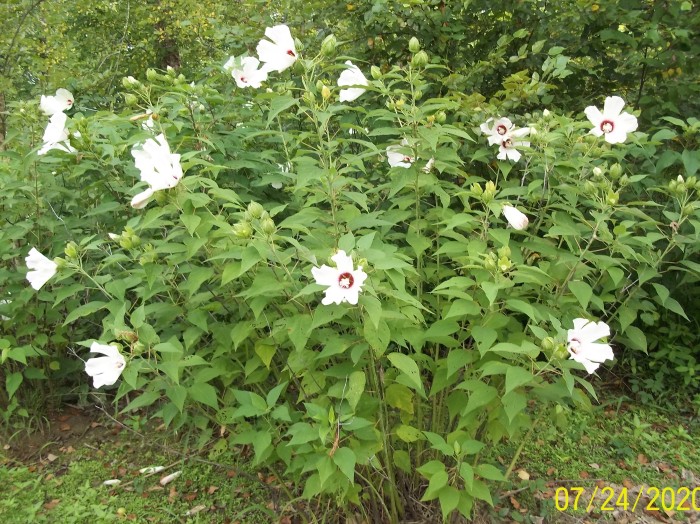
Hibiscus moscheutos (Swamp Rose-mallow)
Plants in small treepots for $6 each (3 for $15)
Plants in large treepots for $8 each (3 for $20)
Since the brutal heat is about to break and there is some rain in the long-range forecast, it will be possible to do some planting in sunnier spots. So several shrubs/small trees and large perennials are on sale for sunnier locations. All of the plants on sale are in treepots so their roots are already deep to help provide a painless transition to a new home. But I would still recommend planting in the late afternoon/early evening and preferably when the next day will be cloudy and/or rainy. And don’t forget to mulch well and properly – no volcano mulching!! (http://richmondtreestewards.org/education/threats-to-trees/volcano-mulching/).
Amorpha fruticosa (Indigo Bush) is a small multi-trunk tree/large shrub that reaches heights of 12 – 15 feet under optimal conditions. It produces stunning deep purple flower spikes in May that attract lots of pollinators. Indigo bush has compound leaves with relatively small leaflets that are quite similar to black locust. Most of the foliage is restricted to the upper half of the trunks providing an open, airy appearance. This plant likes moisture and would be great along the edge of a water feature, near a downspout, or provided with excess water from a rain barrel overflow. If planted in a partially shaded area, it can tolerate some drought and dry soils without supplemental watering. (Available in large treepots and a limited number of small treepots.)
Callicarpa americana (American Beautyberry) is a medium-sized shrub that grows to a height of 6 feet with a horizontal spread of greater than 6 feet. However, it responds fine to pruning so it can be easily managed to the desired size. The small pink flowers are not showy; but the ensuing display of berries is fantastic. Clusters of dark purple berries encircle the stems a few inches apart. The berries appear in late Summer/early Fall and remain on the plant after the leaves have fallen. The berries are eaten by a variety of birds; but they are clearly not a prized food like blueberries and elderberries which are quickly stripped. (Available in large treepots.)
Corylus americana (American hazelnut) is a large multi-trunk shrub that can reach 15 feet high. This extremely adaptable plant can grow in full sun or lots of shade and cares little for soil moisture or fertility. This is the ultimate low-maintenance plant and it takes up a lot of horizontal space with its branches arching over due to the weight of the developing nuts in Summer. Very few weeds can grow under its dense shade and it has year-round interest from red foliage in the Fall to male catkins draping its branches in Winter. Nuts are edible but you will never beat the squirrels to them. (Available in large treepots.)
Hibiscus laevis (Halberd-leaf Rose-mallow) is a large perennial with the superficial appearance of a woody shrub. Although this plant dies back to the ground in the Winter, it produces a tight clump of large stems each Spring that can reach 5-6 feet tall. The major landscape appeal is the beautiful display of large pink flowers with red centers during mid-late Summer. This plant will produce the most flowers in full sun as long as soils are moist; but it can tolerate some shade. These plants were propagated from seeds collected in James River Park (with a permit) where there are scatted populations growing along banks and in the Wetlands. Now is the time to spot this plant since it has started to bloom. (Available in large treepots and in a limited number of small treepots.)
Hibiscus moscheutos (Swamp Rose-mallow) is closely related to Hibisucs laevis. The major physical difference is that the flowers are usually white with a deep red center. Also, this plant is usually found growing in full sun in wetland areas that often having standing water. This is an ideal plant for a rain garden or edge of a pond or other water feature. (Available in large treepots.)
For more pictures and information, consult the Digital Atlas of the Virginia Flora (http://vaplantatlas.org/) or the Lady Bird Johnson Wildflower Center (https://www.wildflower.org/plants-main).
Due to the pandemic, sales are by pre-order only with contact-free pick-up/payment. To order, send an email to: reedycreekenvironmental@gmail.com.
The complete plant list was updated recently and can be viewed here: https://www.dropbox.com/s/v…/RCE%20Plant%20List%202020.docx…
Stay safe.
Bill
